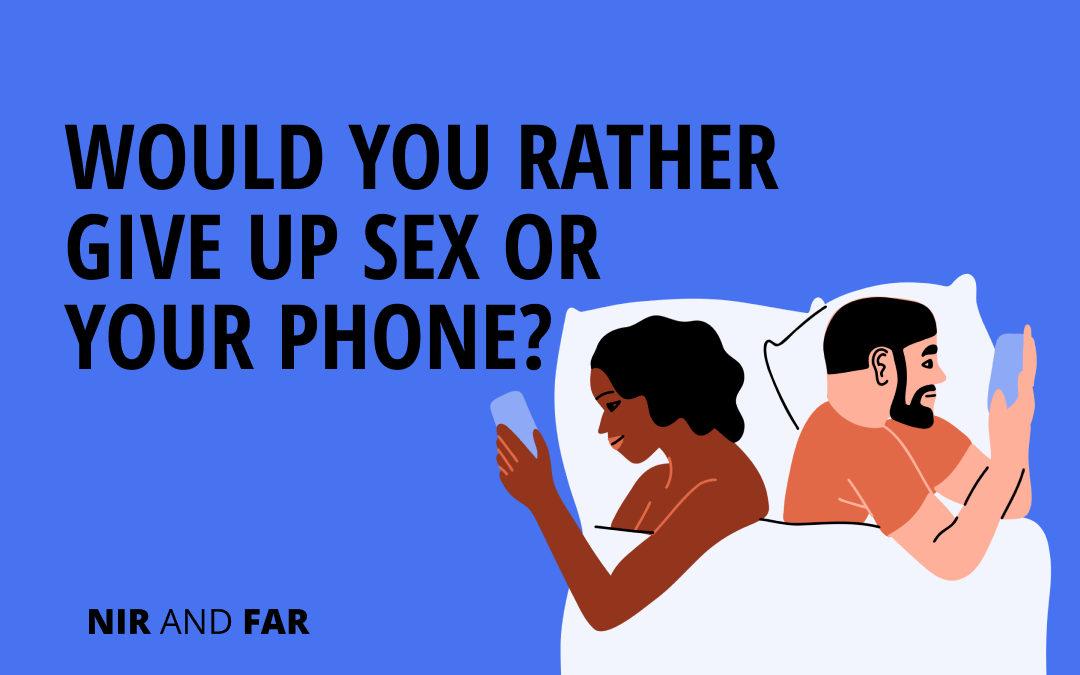Every night, my wife and I engaged in the same routine: She put our daughter to bed, brushed her teeth, and freshened up. We both slipped under the covers, exchanged knowing glances, and started doing what comes naturally to a couple in bed: we began to lovingly caress our gadgets—she fondled her cell phone, while I tenderly stroked the screen of my iPad. Ooh, it felt so good!We were having a love affair—with our gadgets instead of each other.
Apparently, we weren’t the only ones substituting Facebook for foreplay. According to one survey, “almost a third of Americans would rather give up sex for a year than part with their mobile phone for that long.”
Before we learned to become Indistractable, the allure of notifications on our cell phones proved hard to resist. Promising to reply to just one more email after dinner quickly turned into 45 minutes of lost intimacy later that night. We’d fallen into an evening ritual of solitary tech checking until midnight. By the time we each got to bed, we were too tired to talk. Our relationship suffered (not to mention our sex life).
We were among the 65 percent of American adults who, according to the Pew Research Center, sleep with their phones on or next to their beds.
How to be an Indistractable Lover
Since habits rely on a cue to trigger a behavior, action is often sparked by the things around us. We decided to move our phones from our bedroom to the living room, and with the external triggers gone, we regained some control over our techno-infidelity.
But after a few phone-free evenings, I began to notice a stressful anxiety. My mind became occupied with all the things calling for my attention.
Had someone sent me an urgent email? What was the latest comment on my blog about? Did I miss something important on Twitter? The stress was palpable and painful, so I did what anyone who makes a firm commitment to breaking a bad habit would do: I cheated.
With my cell phone unavailable, I needed to find a new partner. To my relief, I felt the anxiety melt away as I pulled out my laptop and began to bang on the keyboard. My wife, seeing what I was doing, pounced on the opportunity to relieve her own stress, and we were back at it again.
After a few late nights on our machines, we sheepishly admitted that we had failed. Embarrassed but determined to understand where we’d gone wrong, we realized we had skipped a critical step. We hadn’t learned to deal with the discomfort that had drawn us back in.
With self-compassion this time, we decided to start by finding ways to manage the internal triggers driving our unwanted behaviors. We implemented a ten-minute rule and promised that if we really wanted to use a device in the evening, we would wait ten minutes before doing so.
The rule allowed us time to “surf the urge” and insert a pause to interrupt the otherwise mindless habit. We also connected our internet router and monitors to $7 outlet timers purchased at a local hardware store and set them to turn off at 10pm each night. This meant that in order to “cheat,” we would have to uncomfortably contort behind our desks and flip the override switch.
We learned to cope with the stress of stopping our compulsion to use technology in the evening, and, over time, it became easier to resist.
We scheduled a strict bedtime, claiming the bedroom as a sacred space and leaving external triggers, like cell phones and the television, outside. The outlet timers that turned off the unwanted distractions made compliance with our commitment something we came to expect every night. We began to use our reclaimed time for more “productive” purposes as we gained greater control over our habits.
Though we were proud of our tech-blocking invention, many routers like the Eero now come with internet shut-off capabilities built-in. If I lose track of time and try to check email after ten o’clock, a message from my router reminds me to get off the computer and go snuggle with my wife.
Distractions can take a toll on even our most intimate relationships. The cost of being able to connect with anyone in the world is that we might not be fully present with the person physically next to us.
My wife and I still love our gadgets and fully embrace the potential of innovation to improve our lives, but we want to benefit from technology without suffering from the corrosive effects it can have on our relationship. By learning to deal with our internal triggers, making time for the things we really want to do, and removing harmful external triggers, we were finally able to conquer the distraction of technology in our relationship.
Related Articles
- Schedule Maker: a Google Sheet to Plan Your Week
- Habit Tracker Template in Google Sheets
- The Ultimate Core Values List: Your Guide to Personal Growth
- Timeboxing: Why It Works and How to Get Started in 2024
- An Illustrated Guide to the 4 Types of Liars
- Hyperbolic Discounting: Why You Make Terrible Life Choices
- Happiness Hack: This One Ritual Made Me Much Happier

